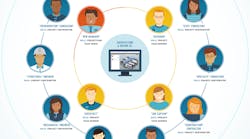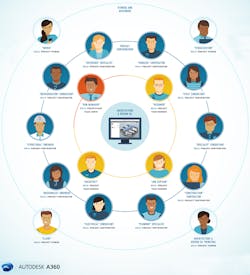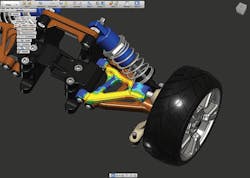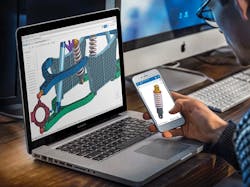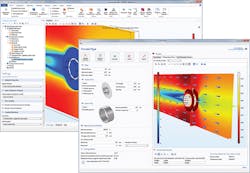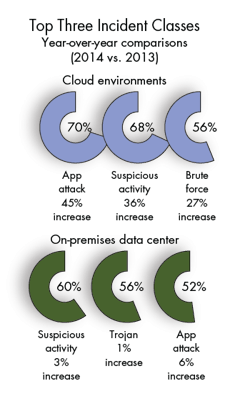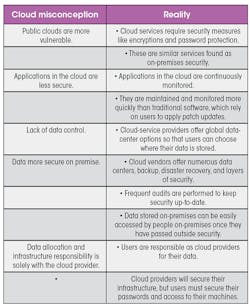This file type includes high-resolution graphics and schematics when applicable.
The idea of “the cloud” for many has become a punchline. Since the term came about for online storage, people have a hard time grasping how to define it. Simply put, the cloud is the location of data or software that does not reside on a local personal computer or area network; rather, it resides on “the cloud”—a global network of linked computers via the Internet.
Use of the cloud is on the rise thanks to the Internet of Things (IoT). Data from automation plants and factory floors is being collected and subsequently shared to floor workers, engineers, plant managers, and CEOs via the Internet. Alert Logic’s 2015 Cloud Security Report predicts that companies will invest $200 billion in cloud services in 2016.
Computer-aided design (CAD) has also gone the cloud route. In the last few years, major CAD companies have promoted not only cloud CAD computing, but also collaboration. They want users to be able share access on design files, taking CAD from the individual user to the multiple user experience.
Latest CAD Solutions
The basic purpose of the cloud is online storage; a place that one can save files on network computers instead of your local desktop. Since 2010, Autodesk Inc.’s A360 service has offered users a way to save their 2D and 3D design models on the cloud. They can access these files remotely from multiple platforms and applications via a computer, laptop, or tablet.
The A360 service also allows users to share their files with others. They can view the document while the originating user controls the original file. One can setup a review session to invite other team members to comment directly within files. The team tracks the latest updates and provides comments to the file on the A360 service. A360 supplies metadata for each file in the cloud and enables users to navigate through older versions of the file.
Increasing access and size of consumer cloud services has pushed the company to extend its capabilities. The next level of Autodesk’s cloud services is Fusion 360. This takes the entire product-development process to a single cloud-based platform.
Originally introduced in 2012, Fusion 360 uses the cloud not only as cloud storage, but also for the software experience. This allows for certain functions: collaboration, infrastructure-free architecture, and automatic updates. Infrastructure free helps prevent loss of data due to the program being located in the cloud and not on your computer. Automatic updates to the program are performed on Autodesk’s cloud service, hence you are always working with the latest and greatest software.
Collaboration is the real draw to using Fusion 360. The current world of IoT is pushing for more connected devices, which compels engineers to work closer together. Fusion 360 allows for distributed design. Designers can work concurrently and update assemblies of the same file. Future updates to Fusion360 will let individual users create their own branches from the original design. Users will review each other’s design, accept changes, and then merge the two separate files back into one file.
Simulation is a big factor within Fusion 360. Users can run simulation on local computers or cloud-based software. In November 2015, Autodesk introduced a new browser-based client Project Leopard, and in January 2016, Autodesk introduced their second wave of simulation. This includes the ability to perform thermal simulations and thermal stress analysis.
Dassault Systemes' 3DEXPERIENCE platform is an all-in-one industry approach to collaborative computer design. The platform includes ENOVIA, Dassault SystemesWYM, EXALEAD, NETVIBES, 3DVIA, DELMIA, SIMULIA, CATIA, GEOVIA, and SOLIDWORKS. It targets several industries, 12 in all, including aerospace/defense, energy, utilities, architecture, engineering, construction, and transportation. For example, the industry package for architecture, engineering, and construction has three industry experiences: optimized construction, façade design for fabrication, and civil design fabrication. Each experience helps provide a complete design path.
On the cloud services, users can assign individual roles. These roles have particular tools and capabilities to work within the project. The 3DEXPERIENCE on the cloud has roles for different industries, including engineering, simulation, ergonomics, machining, robotics, and product planning. “Engineering On Cloud” roles include: 3D master conceptual designer, 3D master designer, mechanical designer, mechanical part designer, mechanical shape and designer, mechanical simulation designer, composite designer, and composite manufacturer. In total, there are 219 assignable roles for on-premises local use and 115 roles on the cloud, whether public or private.
By laying out the architecture through the experiences, users approach their project through the specific industry instead of a direct modeling application approach. For example, instead of using CATIA for 3D modeling or SIMULIA for part simulation, the user will reach those steps by working through the specific industry package.
Other programs have taken alternative approaches to cloud CAD computing by abandoning installed applications altogether. Onshape is a full-cloud 3D CAD system that runs in a web browser and on all mobile platforms, including Android and Apple devices. As compared to Dassault Systemes or Autodesk, no physical version of the application can be installed on your computer. It uses existing product-life-management (PLM) systems, and links to the online model versions can be stored on those PLM systems.
Onshape can read native CAD (SolidWorks, Pro/ENGINEER, CATIA, NX, DWG, etc.) and neutral CAD formats (IGES, SAT, STEP, ACIS, JT, Parasolid, DXF, etc). It offers collaborative cloud design similar to that of Fusion 360 by creating separate versions or branches of files as multiple users work on the same model. There are no license fees or service packs; users pay a monthly subscription.
Another interesting approach to online collaboration and use of the cloud is to provide online simulation applications instead of full access to the software. COMSOL Multiphysics is an advanced modeling and simulating physics-based software platform. The software can simulate 25 different physics-based scenarios, including heat transfer, pipe flow, plasma, acoustics, and CFD. The user can construct 3D models within COMSOL or import files from SOLIDWORKS, AutoCAD, Pro/ENGINEER, and CATIA, among other modeling programs.
The platform will create meshes for finite element analysis that can be automatically generated or user defined. It allows for multiple levels of user-defined input. One can define boundary conditions, materials, direction flow of heat or fluid, source/sink terms, or a unique set of partial differential equations. The COMSOL platform offers each simulation a preset list of equations. However, the user can create their own equations or modify the preset equations. The software also has a set list of variables, expressions, and lookup tables.
The Application Builder for COMSOL is the company’s method of providing simulation software through the cloud. Instead of having users simultaneously work on the same file, you can create an application based on your simulation. The Application Builder takes the analysis and creates a plug-and-play web-based application. The user of the application will have inputs and settings that can be modified while still being a full functional analysis.
For example, if you have developed an analysis of fluid through a pipe, which includes temperature changes, volumetric flow-rate changes, and changes in pipe diameter, these values are modifiable via cloud user inputs. Applications can be hosted on COMSOL’s server or through other third-party cloud services like Amazon or Rescale’s pay-per-use high-performance computing cloud platforms.
Current Obstacles and Tackling Security
The resistance to using cloud services rises from a lack of trust in the technology. First, many companies do not like not owning the software. By using cloud-only platforms, the user is paying for a license to use the software remotely. Hence, they are “renting” the software. You could say this is equivalent to using media stream services; you only have access to the media as long as you continue your subscription.
If the software is physically owned, meaning installed on a physical hard drive, a user or company can continue using the software regardless of subscriptions, support contracts, or non-supported software. Many companies that have legacy software continue to keep those computers around to service legacy programs. This also leads to the next issue—Internet speed and access.
Cloud computing requires fast Internet speed because the files being designed or analyzed can be quite large. Dependence on the Internet means that work comes to a stop once connection is lost or the server is down. According to Akamai, a global leader in content-delivery network services, the United States ranked 16th in the world with an average Internet speed of 12.6 megabits per second (Mb/s), according to its third quarter report for 2015. While no state in particular falls in the low broadband category (< 4 Mb/s), parts of the country fall to as low as 7 Mb/s. In these areas, it may be difficult to implement cloud services.
Besides Ethernet connections, there is Wi-Fi access, which tends to be more complicated. The theoretical max speed of 802.11ac Wi-Fi is 1300 Mb/s. The real speed will vary on distance and antennae connected. In 2013, Anand Tech tested different 802.11ac routers and found max speeds to reach 364 Mb/s at a 5-ft. distance and 140 Mb/s at a 20-ft. distance. These test values are best-case scenarios. Real-world numbers of Wi-Fi are lower when distance, obstructions, and electronic interference are considered.
Security is the biggest concern when it comes to cloud. Users and organizations fear that they will not control their data or hackers will compromise the data. Alert Logic’s 2015 Cloud Security Report concluded that 70% of cloud consumers received application attacks, 56% brute force, and 37% Trojan activity. Compared to on-premises attacks, 52% were application attacks, 47% brute force, and 57% Trojan activity. The increase of attacks on cloud services is most likely because more people are using them more, making them a larger target.
Embracing the Cloud
Acceptance of CAD cloud services will be a challenge in the years to come. Problems will revolve around overcoming fears and understanding the reality of security. Common misconceptions are:
Many companies already use some form of cloud service. Companies that have PLM systems to store and manage their design models use the cloud. Such PLM data centers are often located off-site. The next step is to include the modeling software off-site as well. Advances in technology, security, and standards will help push the cloud forward.
New Wi-Fi connections like Li-Fi hope to increase speeds to 224 gigabits per second (Gb/s). It achieves these speeds by using LEDs to deliver high-speed communication in a similar manner to Wi-Fi. The Wi-Fi Alliance announced a new version of Wi-Fi called HaLow, which transmits Wi-Fi at 900 MHz (current standards are 2.4 GHz and 5 GHz). HaLow is intended to provide connection for small battery devices like wearables or mobile devices, helping to maximize and not drain battery life.
The increase in standards governing cloud services will help boost user as well as company trust in them. Some of the standards in place now, followed by companies like Autodesk and Dassault, include:
• ISO/IEC 27001:2013: Information technology—Security techniques—Information security management systems -- Requirements
• ISO/IEC 27017: Cloud Computing Security and Privacy Management System-Security Controls
• ISO/IEC 27036-x: Multipart standard for the information security of supplier relationship management that is planned to include a part relevant to the cloud supply chain
Security will always be a battle between hackers and the guards of the Internet. While these concerns exist and still loom over full cloud adoption, it seems that the future lies in cloud computing. Dell’s “Global Technology Adoption Index” for 2015 predicts that companies adopting on-premises cloud will have 46% higher growth rates and those adopting off-premises cloud 51% higher growth than companies without cloud services. Like all new technologies, the more it is adopted, the stronger it will become.
